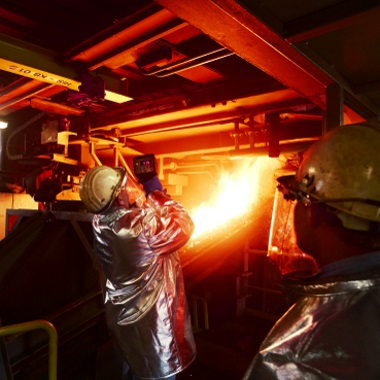Total of four public-private projects granted to Weckhuysen group members within NWO ENW-PPS
A public-private consortium led by prof. Bert Weckhuysen and Ward van der Stam (Chemistry), has been awarded an NWO grant for the project “Transforming carbon-rich industrial waste gases of metallurgical plants into valuable products.” Together with Tata Steel, Leiden University and M2i, the researchers will work towards more sustainable steel production by converting released CO2 into valuable basic chemicals.
The project budget of 2.5 million euros is financed 50% by NWO and 50% by the industrial partners. In addition to this project, another six smaller public-private projects have been awarded to Utrecht researchers within the NWO ENW-PPS-programme.
With a CO2 reduction of more than 50% compared to the conventional blast furnace process, the recently developed HIsarna process is an important step forward in Tata Steel’s ambition of fully carbon-neutral steel production. This consortium is centered around the use of the HIsarna top gas. Tata Steel, Utrecht University, Leiden University and M2i have joined forces to convert the CO2-rich, high-temperature emissions of the HIsarna top gas into valuable basic chemicals by thermo- and electrochemical means. For this purpose, in addition to new catalysts, new thermo- and electrochemical measurement methods will be developed, which are generically applicable in the broader field of catalysis and process technology.
In addition to this project, three smaller public-private projects have been granted to researchers of the Wekchuysen group within the NWO ENW-PPS program.
A road map for the application of lignin
LIFT project (300 k€) for Pieter Bruijnincx and Florian Meirer, with consortium partner BASF
A circular economy needs non-edible biomass as a sustainable source of carbon for the production of materials we use every day. Lignin is a component of this second-generation biomass that has great potential for value creation, but its use also poses considerable technical challenges. In this project we will search for the relationship between lignin’s complex structure and its suitability for different material applications, in order to yield a rational, predictive choice for its ideal application.
Colourless and odourless catalytic hydrogenation
LIFT projct (300 k€) for Bert Weckhuysen, with consortium partners Croda, VibSpec and BASF
Isostearic acid has numerous applications including cosmetics, foods and lubricating oils. Its commercial production is performed by hydrogenating the fatty acid iso-olein, which can be derived from vegetable oils. This process makes use of a combination of fixed catalyst materials, which catalyse the hydrogenation reaction and also remove any undesirable colour and odour components that might negatively influence the properties of the end product. In this research we will look for a new hydrogenation catalyst that allows the selective production of isostearic acid with a high degree of purity. This will be a search for the best catalyst material having the ideal balance of active sites with regard to both acid and metal properties.
Controlling temperature at the (sub)micrometre scale
KIEM project (50 k€) for Bert Weckhuysen and Robin Geitenbeek, with consortium partner DENSsolutions
Small events can have large consequences, especially in the active research field of nanomaterials. However, the performance of nanomaterials and the influence exerted on them by their direct surroundings are difficult to measure. Temperature is a good example of this, with many consequences including product yield and catalytic reaction selectivity. To get a grip on this, a three-part project has been set up; using microreactors (by DENSsolutions) temperature can be controlled on the (sub)micrometre scale, mapped using luminescence thermometry in combination with confocal microscopy, and lastly the resulting knowledge applied research into catalysts and chemical processes in which temperature on this scale is crucial.
Source: website Utrecht University

